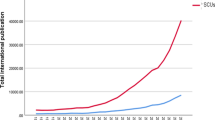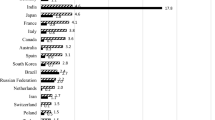Abstract
Scientometric indicators or science metrics, conventional and derived ones, are used in ex-post evaluating of a government policy with impact on research system. Publications, citations, h-index, Glänzel model, and patents are applied in both micro and meso levels. This provides useful insight into the impact of the voluntary early retirement policy on research and technological outputs of the faculties of science in Morocco and consequently on the overall Morocco’s research system. The use of these metrics showed that the effect of the initiative was quite limited by affecting an average of 8% of the professor staffs of these institutions. Furthermore, each professor benefiting from this initiative had produced an average of 3.7 publications indexed in SCI in all his (her) career. The few number of the publications attributed to these professors had been gradually decreasing even 6 years before the initiative. No specific scientific field had intensively been struck. The findings also support that these professors were in general more ‘author’ than ‘inventor’. Inventor-professor institutions were likely more affected by the initiative. By means of these metrics, even if the initiative had not contributed to rejuvenate the professor-staffs of the faculties of science in Morocco, would nevertheless be a stimulus of their research system with respect to their scientometric indicators.



Similar content being viewed by others
References
Agrawal, A., & Henderson, R. (2002). Putting patents in context: Exploring knowledge transfer from MIT. Management Science, 48(1), 44–60.
Bornmann, L., & Daniel, H.-D. (2005). Does the h-index for ranking of scientists really work? Scientometrics, 65(3), 391–392.
Bouabid, H., & Martin, B. R. (2009). Evaluation of Moroccan research using a bibliometric-based approach: Investigation of the validity of the h-index. Scientometrics, 78(2), 203–217.
Bourke, P., & Butler, L. (1998). Institutions and the map of science: Matching university departments and fields of research. Research Policy, 26(6), 711–718.
Breschi, S., Lissoni, F., & Montobbio, F. (2007). The scientific productivity of academic inventors: New evidence from Italian data. Economics of Innovation and New Technology, 16(2), 101–118.
Charlton, B. G., & Andras, P. (2007). Evaluating universities using simple scientometric research-output metrics: Total citation counts per university for a retrospective seven-year rolling sample. Science and Public Policy, 34(8), 555–563.
Csajbok, E., Berhidi, A., Vasas, L., & Schubert, A. (2007). Hirsch-index for countries based on essential science indicators data. Scientometrics, 73(1), 91–117.
Czarnitzki, D., Glänzel, W., & Hussinger, K. (2007). Patent and publication activities of German professors: An empirical assessment of their co-activity. Research Evaluation, 16(4), 311–319.
Glänzel, W. (2006). On the h-index—A mathematical approach to a new measure of publication activity and citation impact. Scientometrics, 67(2), 315–321.
Granadino, B., Plaza, L. M., & Vidal, C. (2005). Analysis of Spanish scientific output following the joint action program (Acciones Integradas) of the Ministry of Science and Technology (MCYT). Research Evaluation, 14(2), 97–102.
Hicks, D., Tomizawa, H., Saitoh, Y., & Kobayashi, S. (2004). Bibliometric techniques in the evaluation of federally funded research in the USA. Research Evaluation, 13(2), 68–78.
Hirsch, J. E. (2005). An index to quantify an individual’s scientific research output. Proceedings of the National Academy of Sciences, 102(26), 16569–16572.
Jimenez-Contreras, E., Anegon, F. D., & Lopez-Cozar, E. D. (2003). The evolution of research activity in Spain—The impact of the National Commission for the Evaluation of Research Activity (CNEAI). Research Policy, 32(1), 123–142.
Katz, J. S. (2000). Scale-independent indicators and research evaluation. Science and Public Policy, 27(1), 23–36.
Martin, B. R., & Irvine, J. (1983). Assessing basic research: Some partial indicators of scientific progress in radio astronomy. Research Policy, 12, 65–69.
Meyer, M. (2006). Are patenting scientists the better scholars? An exploratory comparison of inventor-authors with their noninventing peers in nano-science and technology. Research Policy, 35(10), 1646–1662.
Narin, F. (1987). Bibliometric techniques in the evaluation of research programs. Science and Public Policy, 14(2), 104–106.
Rosenberg, N. (1998). Chemical engineering as a general purpose technology. In E. Helpman (Ed.), General purpose technologies and economic growth (pp. 167–192). Cambridge: MIT Press.
The World Bank. (2006). MENA Regional Governance Case Study: Morocco Voluntary Retirement Program.
Vanclay, J. K. (2006). On the robustness of h-index. Journal of the American Society for Information Science and Technology, 58(10), 1547–1550.
Van Leeuwen, T. N., Van der Wurff, L. J., & Van Raan, A. F. J. (2001). The use of combined bibliometric methods in research funding policy. Research Evaluation, 10(3), 195–201.
Van Looy, B., Callaert, J., & Debackere, K. (2006). Publication and patent behaviour of academic researchers: Conflicting, reinforcing or merely co-existing? Research Policy, 35(4), 596–609.
Van Raan, A. F. J. (2006). Comparison of the Hirsch-index with standard bibliometric indicators and with peer judgment for 147 chemistry research groups. Scientometrics, 67(3), 491–502.
Ventura, O. N., & Mombru, A. W. (2006). Use of bibliometric information to assist research policy making. A comparison of publication and citation profiles of Full and Associate Professors at a School of Chemistry in Uruguay. Scientometrics, 69(2), 287–313.
Vilibic, I. (2009). Bibliometric analysis of the adriatic-related oceanography and meteorology publications. Geofizika, 26(2), 229–243.
Acknowledgments
The authors thank M. Bousmina, D. Aboutajeddeine and T. Bounahmidi, for their valuable and helpful comments.
Author information
Authors and Affiliations
Corresponding author
Rights and permissions
About this article
Cite this article
Bouabid, H., Dalimi, M. & ElMajid, Z. Impact evaluation of the voluntary early retirement policy on research and technology outputs of the faculties of science in Morocco. Scientometrics 86, 125–132 (2011). https://doi.org/10.1007/s11192-010-0271-z
Received:
Published:
Issue Date:
DOI: https://doi.org/10.1007/s11192-010-0271-z




